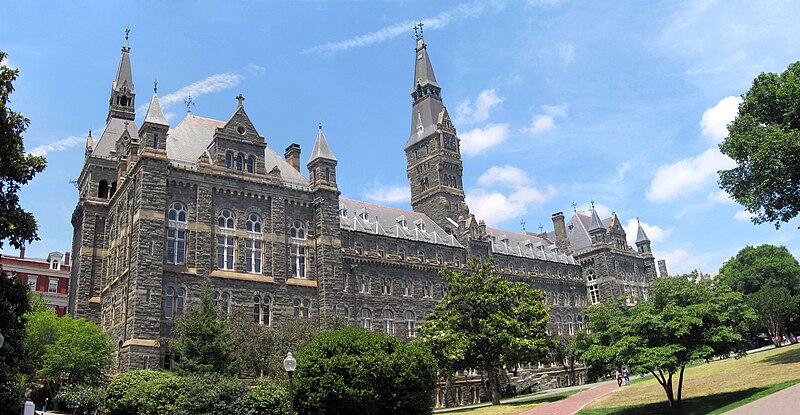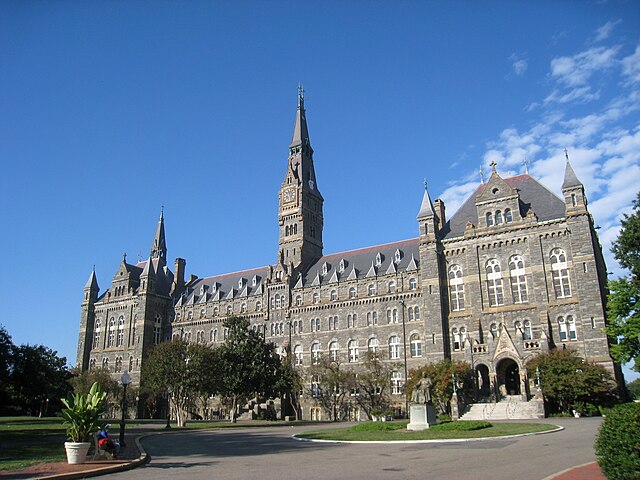
As Thammasat University students grow accustomed to online learning and distance education, some may wish to explore overseas opportunities after they have done their required coursework. Taking an extra class may be informative and help complement main areas of study, giving students new ideas and perspectives and help them to practice their English language usage.
One opportunity to consider may be free massive open online courses (MOOCs) at Georgetown University.
Georgetown University is a private research university in the Georgetown neighborhood of Washington, D.C. It comprises ten undergraduate and graduate schools, among which are the School of Foreign Service, School of Business, Medical School, Law School, and a campus in Qatar. Located on a hill above the Potomac River, the school’s main campus is identifiable by its flagship Healy Hall, a National Historic Landmark.
Georgetown is home to the country’s largest student-run business, largest student-run financial institution, the oldest continuously running student theatre troupe, and one of the oldest debating societies in the United States.
The Thammasat University Library owns a number of books published by Georgetown University Press, a leading academic publisher.
Among possible MOOCs at Georgetown University is Sign Language Science: Emergence and Evolution of Sign Language:
This course connects the emergence and evolution of signed languages to the history of the people who use these languages. You will learn this concept in depth, especially the legacy and heritage of American Sign Language (ASL).
About this course
ASL has a long history and good documentation. This course, Emergence and Evolution of Sign Language, explores the origins of ASL by beginning with the key events and key concepts. How do people learn signed languages? Why do people enjoy using them? This key information will provide a foundation for understanding the relationship between how people use language, how it’s learned, and how a language community is formed and sustained. This foundation will illustrate how the language survives, which is equally important to recognize. These ideas will be discussed in this core course and they provide a foundation of understanding about where language comes from and why they vary.
What you’ll learn
- By the end of the course learners should be able to:
- State the role that iconicity plays in the emergence and evolution of ASL
- Define the term “chereology”
- Identify the primary and secondary parameters in sign formation
- Describe the nature of cognitive encoding of individual signs
- Describe the nature of language-specific constraints on sign formation
- Distinguish between conventionalization and innovation in sign language
The course instructor will be Professor Ted Supalla, Professor of Neurology, Linguistics, and Psychology at Georgetown University.

Another potential choice among the MOOCs at Georgetown is How the U.S. Government Works & How to Get Involved:
This is not your average government class: Our primer offers an overview of the basics, how they apply today, plus the tools you need to make your voice heard.
About this course
Feeling overwhelmed by modern-day politics? Looking to get involved but not sure where—or how—to start? Wondering what you can do to channel your energy into action and make a difference? This course is for you. Led by expert faculty from Georgetown University, How the Government Works & How to Get Involved offers a refresher on the fundamentals of American government in the context of what’s happening right now. You’ll leave the course with the tools you need to become an engaged, empowered citizen and make your voice heard.
This course will cover a range of topics including the structure, function, and organization of the three branches of government, proven strategies to influence government, the relationship between the government and the media, American foreign policy, and how U.S. citizens can actively participate in shaping the government.
How the U.S. Government Works & How to Get Involved is a self-paced course, which allows you to progress through the content at your own speed.
What you’ll learn
- By successfully completing this course you will be able to:
- Explain the structure and responsibilities of the executive branch
- Describe the leadership structure, committee structure, and legislative process of the legislative branch
- Articulate the purpose, structure, operations, and political nature of the federal judiciary
- Explain the purpose of interest groups, describe how to join an interest group, and discuss the responsibilities associated with being a member of an interest group
- Discuss legal and economic issues surrounding the news media, explain the newsmaking process, and assess the legitimacy of news organizations and the reliability of information sources
- Demonstrate how to get involved with the U.S. government and how to implement strategies to influence the newsmaking process
The class will be taught by Professor Lynn Ross, Faculty Director for Master of Policy Management; Professor Anne Cammisa, Associate Director of Master of Arts in American Government, Visiting Professor of Government; Associate Professor Mark Rom, McCourt School of Public Policy; and Professor Clyde Wilcox, Professor of Government, all of Georgetown University.
Yet another MOOC offered at Georgetown is Terrorism and Counterterrorism:
About this course
Terrorism has gone from a persistent yet marginal security concern to one of the most important security problems of our day. There are few countries that do not suffer from some form of terrorism. Though many attempts at terrorism fail, some groups wage lengthy and bloody campaigns and, in exceptional cases, kill hundreds or even thousands in pursuit of their ends.
This course on terrorism will explore the nuances involved in defining terrorism; the nature of Al Qaeda, Hamas, the Islamic State, and other important groups; the effectiveness of different counterterrorism tools; terrorist recruiting, counterterrorism and the rule of law; the political context in South Asia and the Middle East; and the terrorist use of technology.
For those interested in an abbreviated version of this course, the 3-section course Terrorism and Counterterrorism: An Introduction is available here.
What you’ll learn
- Recall the working definitions of terrorism and recognize their analytic limits
- Identify a range of causes of terrorism
- Understand the strategies and tactics of terrorist groups such as Al Qaeda, Hamas, and the Islamic State
- Identify important terrorist groups in the Middle East and South Asia with an understanding of their strengths, weaknesses, and overall effectiveness; these include Palestinian groups, Pakistani groups, and Al-Qaeda
- Understand how counterterrorism is constrained in a democratic society and several important legal debates related to counterterrorism
Course instructors will include Professor Daniel Byman, Edmund A. Walsh School of Foreign Service; Assistant Professor Christine Fair, Security Studies Program; and Professor Bruce Hoffman, Edmund A. Walsh School of Foreign Service, all of Georgetown University.
(All images courtesy of Wikimedia Commons)

